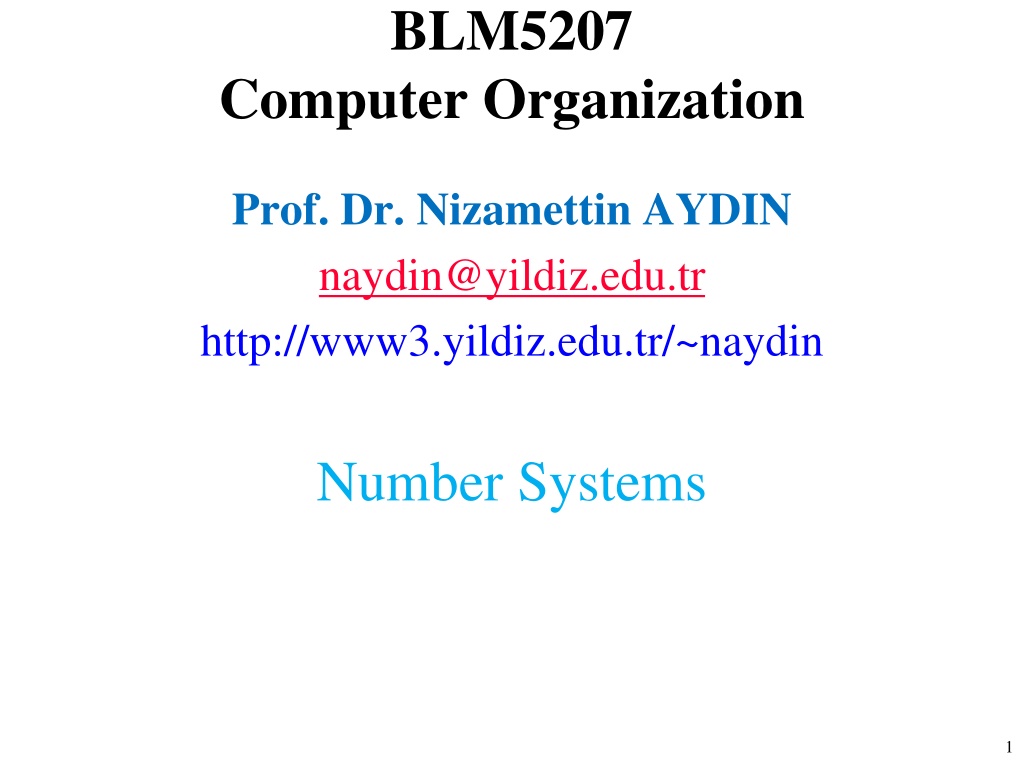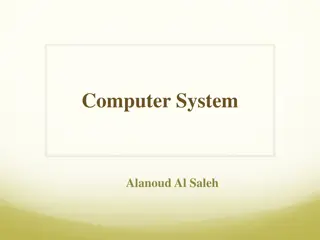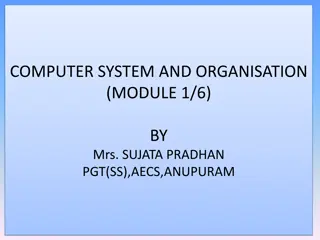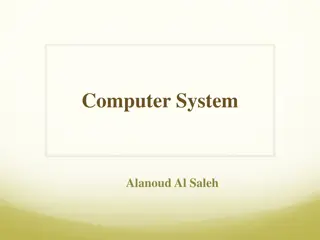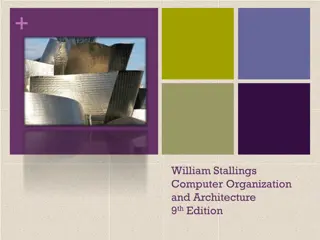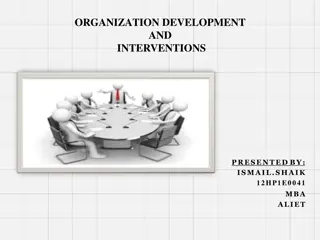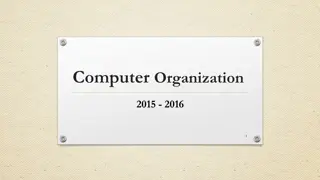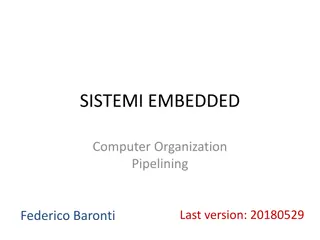BLM5207 Computer Organization
Dive into the world of binary data processing and number systems with a focus on the significance of using binary in early computer design. Explore the fundamentals of binary, decimal, octal, and hexadecimal numbering systems. Understand how bits are grouped, stored, and manipulated, impacting the accuracy and limits of computer calculations. Discover the evolution of numeral representation and the positional notation in various number systems.
Download Presentation

Please find below an Image/Link to download the presentation.
The content on the website is provided AS IS for your information and personal use only. It may not be sold, licensed, or shared on other websites without obtaining consent from the author.If you encounter any issues during the download, it is possible that the publisher has removed the file from their server.
You are allowed to download the files provided on this website for personal or commercial use, subject to the condition that they are used lawfully. All files are the property of their respective owners.
The content on the website is provided AS IS for your information and personal use only. It may not be sold, licensed, or shared on other websites without obtaining consent from the author.
E N D
Presentation Transcript
BLM5207 Computer Organization Prof. Dr. Nizamettin AYDIN naydin@yildiz.edu.tr http://www3.yildiz.edu.tr/~naydin Number Systems 1
Why Binary? Early computer design was decimal Mark I and ENIAC John von Neumann proposed binary data processing (1945) Simplified computer design Used for both instructions and data Natural relationship between on/off switches and calculation using Boolean logic On True Yes 1 Off False No 0 2
Counting and Arithmetic Decimal or base 10 number system Origin: counting on the fingers Digit from the Latin word digitus meaning finger Base: the number of different digits including zero in the number system Example: Base 10 has 10 digits, 0 through 9 Binary or base 2 Bit (binary digit): 2 digits, 0 and 1 Octal or base 8: 8 digits, 0 through 7 Hexadecimal or base 16: 16 digits, 0 through F Examples: 1010= A16; 1110= B16 3
Keeping Track of the Bits Bits commonly stored and manipulated in groups 8 bits = 1 byte 4 bytes = 1 word (in many systems) Number of bits used in calculations Affects accuracy of results Limits size of numbers manipulated by the computer 4
Numbers: Physical Representation Different numerals, same number of oranges Cave dweller: IIIII Roman: V Arabic: 5 Different bases, same number of oranges 510 1012 123 5
Number System Roman: position independent Modern: based on positional notation (place value) Decimal system: system of positional notation based on powers of 10. Binary system: system of positional notation based powers of 2 Octal system: system of positional notation based on powers of 8 Hexadecimal system: system of positional notation based powers of 16 6
Positional Notation: Base 10 43 = 4 x 101+ 3 x 100 1 s place 10 s place Place 101 100 Value 10 1 Evaluate 4 x 10 3 x1 Sum 40 3 7
Positional Notation: Base 10 527 = 5 x 102+ 2 x 101+ 7 x 100 1 s place 100 s place 10 s place Place 102 101 100 Value 100 10 1 Evaluate 5 x 100 2 x 10 7 x1 Sum 500 20 7 8
Positional Notation: Octal 6248= 40410 8 s place 64 s place 1 s place Place 82 81 80 Value 64 8 1 Evaluate Sum for Base 10 6 x 64 2 x 8 4 x 1 384 16 4 9
Positional Notation: Hexadecimal 670416= 2637210 4,096 s place 256 s place 1 s place 16 s place Place 163 162 161 160 Value 4,096 256 16 1 Evaluate 6 x 4,096 7 x 256 0 x 16 4 x 1 Sum for Base 10 24,576 1,792 0 4 10
Positional Notation: Binary 1101 01102= 21410 Place 27 26 25 24 23 22 21 20 Value 128 64 32 16 8 4 2 1 Evaluate 1 x 128 1 x 64 0 x 32 1 x16 0 x 8 1 x 4 1 x 2 0 x 1 Sum for Base 10 128 64 0 16 0 4 2 0 11
Estimating Magnitude: Binary 1101 01102= 21410 1101 01102> 19210(128 + 64 + additional bits to the right) Place 27 26 25 24 23 22 21 20 Value 128 64 32 16 8 4 2 1 Evaluate 1 x 128 1 x 64 0 x 32 1 x16 0 x 8 1 x 4 1 x 2 0 x 1 Sum for Base 10 128 64 0 16 0 4 2 0 12
Range of Possible Numbers R = BKwhere R = range B = base K = number of digits Example #1: Base 10, 2 digits R = 102= 100 different numbers (0 99) Example #2: Base 2, 16 digits R = 216= 65536 or 64K 16-bit PC can store 65536 different number values 13
Decimal Range for Bit Widths Bits 1 4 8 10 16 20 32 64 128 Digits 0+ 1+ 2+ 3 4+ 6 9+ 19+ 38+ Range 2 (0 and 1) 16 (0 to 15) 256 1,024 (1K) 65,536 (64K) 1,048,576 (1M) 4,294,967,296 (4G) Approx. 1.6 x 1019 Approx. 2.6 x 1038 14
Base or Radix Base: The number of different symbols required to represent any given number The larger the base, the more numerals are required Base 10: 0,1, 2,3,4,5,6,7,8,9 Base 2: 0,1 Base 8: 0,1,2, 3,4,5,6,7 Base 16: 0,1,2,3,4,5,6,7,8,9,A,B,C,D,E,F 15
Number of Symbols vs. Number of Digits For a given number, the larger the base the more symbols required but the fewer digits needed Example #1: 6516 10110 1458 110 01012 Example #2: 11C16 284104348 1 0001 11002 16
Counting in Base 2 Equivalent 4 s (22) Binary Number Decimal Number 8 s (23) 2 s (21) 1 s (20) 0 1 0 x 20 1 x 20 0 x 20 1 x 20 0 1 2 3 4 5 6 7 8 9 10 11 100 101 110 111 1000 1001 1010 1 x 21 1 x 21 1 x 22 1 x 22 1 x 22 1 x 22 1 x 20 1 x 21 1 x 21 1 x 20 1 x 23 1 x 23 1 x 23 1 x 20 1 x 21 10 17
Base 10 Addition Table 310+ 610= 910 + 0 1 2 3 4 5 6 7 8 9 0 0 1 2 3 4 5 6 7 8 9 1 1 2 3 4 5 6 7 8 9 10 2 2 3 4 5 6 7 8 9 10 11 3 3 4 5 6 7 8 9 10 11 12 4 4 5 6 7 8 etc 9 10 11 12 13 18
Base 8 Addition Table 38+ 68= 118 + 0 1 2 3 4 5 6 7 0 0 1 2 3 4 5 6 7 1 1 2 3 4 5 6 7 10 2 2 3 4 5 6 7 10 11 3 3 4 5 6 7 10 11 12 4 4 5 6 7 10 11 12 13 5 5 6 7 10 11 12 13 14 6 6 7 10 11 12 13 14 15 7 7 10 11 12 13 14 15 16 Because the base is 8, there is no 8 or 9. 19
Base 10 Multiplication Table 310 610= 1810 x 0 1 2 3 4 5 6 7 8 9 0 0 1 1 2 3 4 5 6 7 8 9 2 2 4 6 8 10 12 14 16 18 3 3 6 9 12 15 18 21 24 27 4 0 4 8 12 16 20 24 28 32 36 5 5 10 15 20 25 30 35 40 45 6 6 12 18 24 30 36 42 48 54 7 7 14 21 28 35 42 49 56 63 etc. 20
Base 8 Multiplication Table 38 68= 228 x 0 1 2 3 4 5 6 7 0 0 1 1 2 3 4 5 6 7 2 2 4 6 10 12 14 16 3 0 3 6 11 14 17 22 25 4 4 10 14 20 24 30 34 5 5 12 17 24 31 36 43 6 6 14 22 30 36 44 52 7 7 16 25 34 43 52 61 21
Addition Base Problem Largest Single Digit 6 Decimal 9 +3 6 +1 6 +9 Octal 7 Hexadecimal F 1 Binary 1 +0 22
Addition Base Problem Carry 6 +4 6 +2 6 +A 1 +1 Answer Decimal Carry the 10 10 Octal Carry the 8 10 Hexadecimal Carry the 16 10 Binary Carry the 2 10 23
Binary Arithmetic 1 1 1 1 1 1 1 0 1 0 1 0 0 1 1 0 0 1 1 1 0 1 + 1 0 0 + 0 0 1 1 1 Addition Boolean using XOR and AND Multiplication AND Shift Division 0 1 10 0 0 0 1 0 1 x 0 1 24
Binary Arithmetic: Boolean Logic Boolean logic without performing arithmetic EXCLUSIVE-OR Output is 1 only if either input, but not both inputs, is a 1 AND (carry bit) Output is 1 if and only both inputs are a 1 1 1 1 1 1 1 1 0 1 0 1 0 0 1 1 0 0 1 1 1 0 1 + 1 0 0 25
Binary Multiplication Boolean logic without performing arithmetic AND (carry bit) Output is 1 if and only both inputs are a 1 Shift Shifting a number in any base left one digit multiplies its value by the base Shifting a number in any base right one digit divides its value by the base Examples: 1010 shift left = 10010 1010 shift right = 110 102 shift left = 1002 102 shift right = 12 26
Binary Multiplication 1 1 0 1 1 0 1 1 1 0 1 1 s place 0 0 0 0 2 s place 4 s place (bits shifted to line up with 4 s place of multiplier) 1 1 0 1 Result (AND) 1 0 0 0 0 0 1 27
Binary Multiplication 1 1 0 1 1 0 1 x 1 0 0 1 1 0 2 s place (bits shifted to line up with 2 s place of multiplier) 1 1 0 1 1 0 1 4 s place 1 1 0 1 1 0 1 32 s place 1 1 0 1 1 0 1 Result (AND) Note the 0 at the end, since the 1 s place is not brought down. 1 0 0 0 0 0 0 1 0 1 1 1 0 Note: multiple carries are possible. 28
Converting from Base 10 Powers Table Power Base 8 7 6 5 4 3 2 1 0 2 256 128 64 32 16 8 4 2 1 8 32,768 4,096 512 64 8 1 16 65,536 4,096 256 16 1 29
From Base 10to Base 2 4210= 1010102 Power 6 5 4 3 2 1 0 Base 2 64 32 16 8 4 2 1 1 0 1 0 1 0 Integer 42/32 = 1 10/16 = 0 10/8 = 1 2/4 = 0 2/2 = 1 0/1 = 0 Remainder 10 10 2 2 0 0 30
From Base 10to Base 2 Base 10 42 Remainder Quotient 2 ) 42 ( 0 Least significant bit 2 ) 21 ( 1 2 ) 10 ( 0 2 ) 2 ) 2 ) 5 ( 1 2 ( 0 1 1 0 1 0 1 0 Most significant bit Base 2 31
From Base 10to Base 16 573510= 166716 Power 4 3 2 1 0 Base 16 65,536 4,096 256 16 1 1 6 6 7 7 5,735 /4,096 = 1 1,639 / 256 = 6 103 /16 = 6 Integer 5,735 - 4,096 = 1,639 1,639 1,536 = 103 103 96 = 7 Remainder 32
From Base 10to Base 16 Remainder Base 10 5,735 16 ) 16 ) 16 ) 16 ) 16 ) 5,735 ( 7 Least significant bit 358 ( 6 22 ( 6 1 ( 1 Most significant bit 0 Quotient Base 16 1667 33
From Base 10to Base 16 Remainder Base 10 8,039 16 ) 16 ) 16 ) 16 ) 16 ) 8,039 ( 7 Least significant bit 502 ( 6 31 ( 15 1 ( 1 Most significant bit 0 Quotient Base 16 1F67 34
From Base 8to Base 10 72638= 376310 72638 = 3,76310 Power 83 82 81 80 512 64 8 1 x 7 x 2 x 6 x 3 Sum for Base 10 3,584 128 48 3 35
From Base 8to Base 10 72638= 376310 7 x 8 56 + 2 = 58 x 8 464 + 6 = 470 x 8 3760 + 3 = 3,763 36
From Base 16 to Base 2 The nibble approach Hex easier to read and write than binary Base 16 1 F 6 7 Base 2 0001 1111 0110 0111 Why hexadecimal? Modern computer operating systems and networks present variety of troubleshooting data in hex format 37
Fractions Number point or radix point Decimal point in base 10 Binary point in base 2 No exact relationship between fractional numbers in different number bases Exact conversion may be impossible 38
Decimal Fractions Move the number point one place to the right Effect: multiplies the number by the base number Example: 139.010 139010 Move the number point one place to the left Effect: divides the number by the base number Example: 139.010 13.910 39
Fractions: Base 10 and Base 2 0.258910 Place Value Evaluate Sum 10-1 1/10 2 x 1/10 0.2 10-2 1/100 5 x 1/100 0.05 10-3 1/1000 8 x 1/1000 0.008 10-4 1/10000 9 x1/1000 0.0009 0.1010112= 0.67187510 Place Value Evaluate Sum 2-1 1/2 2-2 1/4 2-3 1/8 1x 1/8 0.125 2-4 1/16 0 x 1/16 2-5 1/32 1 x 1/32 0.03125 2-6 1/64 1 x 1/64 0.015625 1 x 1/2 0.5 0 x 1/4 40
Fractions: Base 10 and Base 2 No general relationship between fractions of types 1/10kand 1/2k Therefore, a number representable in base 10 may not be representable in base 2 But: the converse is true: all fractions of the form 1/2kcan be represented in base 10 Fractional conversions from one base to another are stopped If there is a rational solution or When the desired accuracy is attained 41
Mixed Number Conversion Integer and fraction parts must be converted separately Radix point: fixed reference for the conversion Digit to the left is a unit digit in every base B0is always 1 regardless of the base 42
